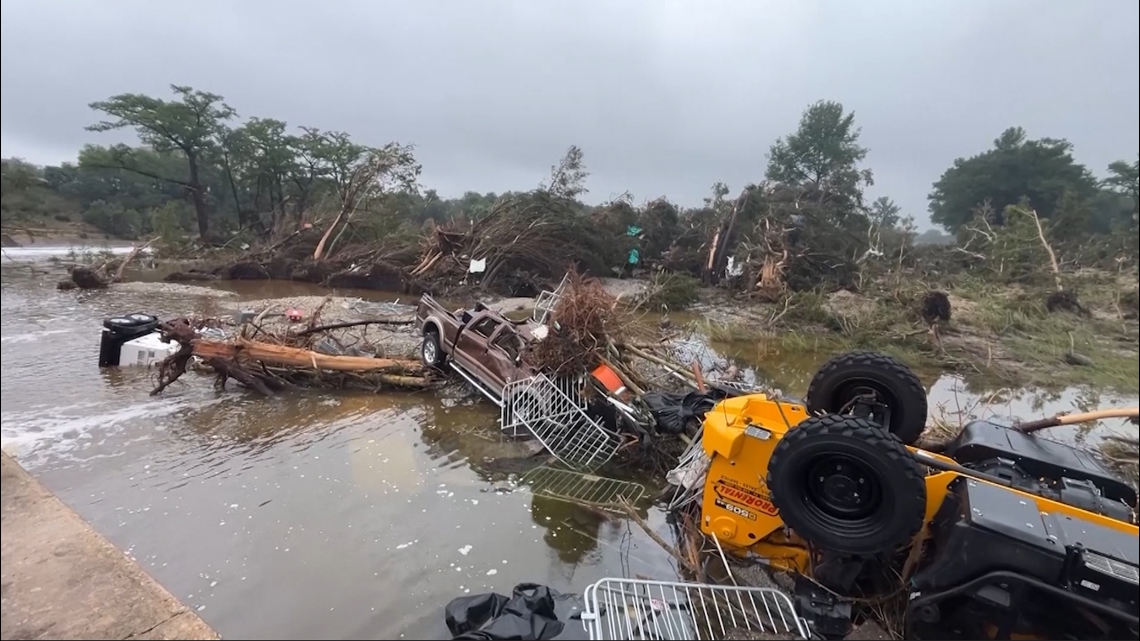
The House Culture, Recreation & Tourism Committee heard testimony from a variety of stakeholders about emergency preparedness and the response to floods.
AUSTIN, Texas — Even though there are not enough members for a quorum to vote on bills on the Texas House floor, House Republicans are pushing ahead on hearings and legislation related to the recent flooding, in hopes of strengthening the state against future disasters.
The House Culture, Recreation & Tourism Committee heard testimony on Wednesday from a variety of stakeholders, including youth summer camps, about emergency preparedness and the response to floods and other natural disasters.
The July 4 floods caused widespread devastation in parts of the state. Authorities said at least 135 people are dead, many in the Kerr County area.
Only the five Republicans on the panel were present at the hearing on Wednesday. The four Democratic House members are out of state and part of the contingent of House Democrats who have left Texas to break quorum to block or delay consideration of a proposed new congressional map.
The committee is still able to meet and hold hearings because the five Republicans constitute a quorum in the committee.
State lawmakers heard testimony from several panels, including the Texas Parks and Wildlife Department, the Texas Historical Commission, Texas Youth Camps and the Texas Hotels, Campgrounds, and Lodging Industry.
“It’s hard to see the devastation,” said Meg Clark, the owner and executive director of Camp Waldemar, an all-girls camp located along the North Fork of the Guadalupe River in Hunt. “We’re all grieving alongside those families.”
The Texas Parks and Wildlife Department discussed the impact of habitat preservation and conservation on mitigating flood damage and the effects of the Hill Country floods on wildlife and fish populations.
The Texas Historical Commission discussed the vulnerability of Texas monuments and historic sites to natural disasters and provided recommendations to enhance their resilience.
Clark said the camper cabins at Waldemar, which are located on a bluff above the river, did not take on any floodwater within the cabins. All campers were safe and accounted for.
However, because there are numerous low-water bridges in the area around the camp, Clark said evacuating children at night or any time during a flood would have devastating results. Their plan has always been to stay put and shelter in place.
The Texas Department of State Health Services requires youth camps to have emergency plans in place. Clark said the plan outlines procedures for a wide range of scenarios and the plans are updated regularly.
“Every summer, we begin with a multi-day orientation training for all of our staff,” Clark said. “We cover everything from emergency protocols, campus supervision, mental health awareness and severe weather procedures. During heavy storms, campers stay in their cabin or other inside locations, depending on whether they are in class time. If lightning is detected, we shut down the classes and move all the kids to their designated sheltered area.”
Cell service is notoriously spotty in Hunt, where several summer camps – including Camp Mystic and Camp Waldemar – sit along the Guadalupe River. Clark said they rely on a two-way radio system using long- and short-range walkie-talkies.
“Safety is just not a box that we check. It’s actually a culture we are cultivating,” Clark said. “Everything we do, and all of our training, and the way we’re laid out, and everything that we speak, it is truly in the forefront of our mind at all times.”
Steve Baskin with Camp Champions in Marble Falls, who is also the board chair of the American Camp Association, testified that safety is their top priority, but there is more that can be done.
Camp Champions, which is located on Lake LBJ, was not directly impacted by the flood. Baskin said one challenge is that this isn’t a one-size-fits-all issue because every camp is different.
“There’s no single standard for different kinds of safety, and they vary with localities,” Baskin said. “Lakes flood differently from rivers. Rivers flood differently from creeks. Each has its hydrodynamic consequences or considerations, and they need to be taken into consideration.
Baskin came with suggestions for state lawmakers to consider, such as clarifying what needs to be included in emergency plans at each camp, outlining how to deal with natural disasters, lost campers, fires, transportation emergencies, severe illnesses, injuries, strangers at camp and aquatic emergencies.
“These plans should coordinate with local authorities and first responders,” Baskin said. “These groups have insights and expertise not just in protocols, but protocols surely specific, which differ depending on where you are.”
Baskin also discussed the need to develop a communication system that would work even in the event of a cell or power outage, such as using air horns or relying on word of mouth.
Baskin said camps should also have multiple interlocking methods to assess whether, in emergencies, clear training for staff on those procedures.
“You can’t fix yesterday,” State Rep. Mano DeAyala (R-Houston) said. “But you can use yesterday to fix tomorrow.”
House lawmakers are considering several pieces of legislation in response to the deadly and devastating flooding, including establishing the Texas Interoperability Council for a statewide strategic communications plan
There is also considerable discussion about early warning systems and interoperability improvements, which can be facilitated through grants and loans. Lawmakers have also discussed requiring campgrounds to have a disaster flood plan.
Lawmakers asked camp leaders for their thoughts on the idea of installing warning sirens in flash flood-prone areas of Texas. Many people may silence weather alerts on their phones or even not receive them if they’re in remote areas, but outdoor sirens provide warnings that can’t be missed and can save lives.
There has been a lot of discussion on combining old-tech sirens with new-tech cellphones to disseminate emergency messaging and layering emergency alerts, especially those that cannot be silenced or missed due to reception.
But the camp leaders at Wednesday’s hearing said they have mixed emotions on that.
“It would depend on how it sounds, if it’s so alarming to children, which worries me, to traumatize children,” Clark said. “I would want to be very cautious, where if it’s more of an internal way that they’re familiar with, a sound that we practice and a sound that they’re, that just may not strike fear in a child.”
Baskin expressed concern over the frequency of its use and what triggers it in terms of watches and warnings. He too expressed concern about it feeding into what he said was a cycle of anxiety among kids.
“If we’re going to test it weekly during the summer to make sure everything is okay, that’s not a great idea,” he said. “But if it’s something that only kicks in in an emergency and it’s reliable, that sounds to me like not a bad idea.”
State Rep. Cody Vasut asked the camp leaders about proposing a blanket rule to ban cabins in areas vulnerable to flooding.
While Baskin said it would make sense in areas like those along the Guadalupe River, where the water can come surging up quickly, it makes less sense for other camps, such as those along lakes. Baskin said it is better to put cabins closer to the water because it is not as hot for campers, and they are less likely to suffer from dehydration and similar issues.
After hearing testimony on a handful of priority bills related to disaster preparedness, flood relief and warning systems in the wake of the July floods, the House Special Committee for Disaster Preparedness left the five bills pending on Tuesday.
With Democrats gone, the House chamber can’t vote on any bills.
